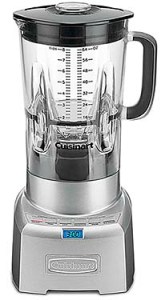Oct 15 2010
Eastman Chemical Company has announced that Cuisinart has introduced a new powerful and multifunctional blender featuring a jar made with Eastman Tritan™ copolyester. Tritan is a new-generation copolyester that offers a balance between clarity of material and material toughness, along with heat resistance. Most importantly, Tritan is manufactured without bisphenol-A (BPA).
 PowerEdge™ 1000-Watt Blender featuring a jar made with Eastman Tritan™ copolyester
PowerEdge™ 1000-Watt Blender featuring a jar made with Eastman Tritan™ copolyester
Cuisinart’s 64-ounce, PowerEdge™ 1000-Watt Blender with die-cast metal housing provides home cooks with a product that combines innovative technology with power and performance. The unit features Auto Preset Programming for Smoothie, Ice Crush, and Pulse – preset programs that synchronize timed pauses with bursts of power during blending for optimum results. The unit is the company’s most powerful and largest-capacity blender to date, and features Cuisinart’s first-ever plastic blender jar made with Eastman Tritan™ copolyester.
“Due to the blender’s large jar capacity, it needed to be lightweight and easy to maneuver for consumers,” said Mary Rodgers, Director of Marketing Communications for Cuisinart. “Eastman Tritan™copolyester offered a light alternative to glass that allowed us to maintain our commitment to the health and safety of our customers by providing a BPA-free jar with glasslike clarity and a quality aesthetic.”
Cuisinart selected Eastman Tritan™ copolyester from a variety of other materials because it is manufactured without BPA and is extremely dishwasher durable, being able to withstand repeated dishwashing cycles without cracking or hazing. Unlike other BPA-free alternatives, Tritan also offers added toughness because it is shatter-resistant, ensuring a long-lasting, dependable blender jar.
“Manufacturing with glass can restrict design and processing capabilities,” Rodgers said. “By utilizing Eastman Tritan™ copolyester for the blender jar, Cuisinart gained extra design freedom, as well as ease of processing during manufacturing.” She explained that by using Tritan, Cuisinart was able to be more creative with stenciling, coloring and other design aspects of the blender jar.
Eastman Tritan™ copolyester was introduced into the housewares and small appliance industry in 2007 and has been utilized in several small appliances, including blenders, food processors, steamers and coffeemakers. The Cuisinart PowerEdge™ Blender is being sold in specialty retail and department stores, including Williams-Sonoma, Macy’s and Bloomingdale’s.
To help increase awareness about the use of Eastman Tritan™ copolyester in products, Cuisinart joined Eastman’s new ingredient branding program that showcases the competitive advantage of using Tritan in its newest blender. Eastman’s program provides clients with marketing materials and information to elevate brand impressions and consumer attitudes toward the product, ultimately enhancing its value in the marketplace.